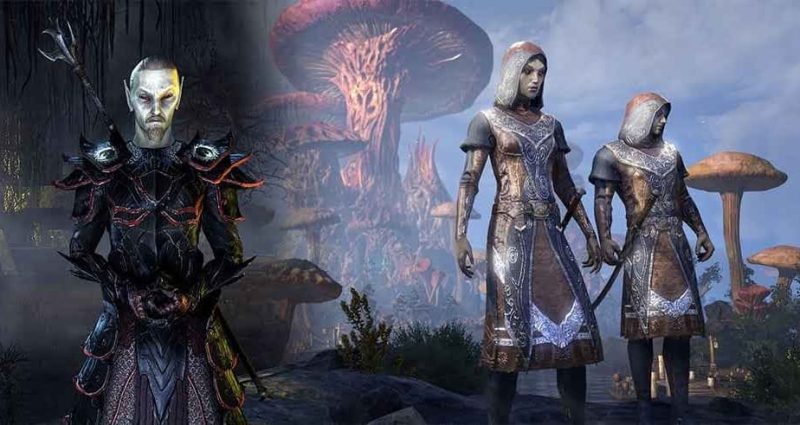Alongside orcs, dragons, and werewolves, the Elder Scrolls franchise has included many common fantasy tropes while providing their spin on them. One example would be Vampires, a common foe for horror and fantasy stories. While they possess many of the standard tropes, such as blood-sucking and hating the sun, Bethesda added to their mythos.
As with all factions in the series, Bethesda gives them a long backstory and surprising subversion on their typical cliches. Here is a breakdown of the sinister Vampires from the Elder Scrolls franchise and how they compare to other depictions from across fiction.
Vampires from This Series
Since Bram Stoker published his original Dracula, the vampire has been the subject of many incarnations. The Elder Scrolls builds upon many of the classic attributes. As usual, the Vampires of this franchise are an ostracised group of the undead who possess powerful necromantic abilities. They spread the disease, Sanguinare Vampiris, simply by attacking their prey. Afterward, players must take a “cure disease” potion within three days before the effects become permanent.
One of the biggest questions players have is how to cure vampirism, given its adverse effects. In Skyrim, players had to go to the mage Falion in Morthal to have him perform a ritual using a black soul stone. In Oblivion, players must seek out the Mage’s Guild, go to a witch in Drakelowe, and enact a ritual with several obscure ingredients.
Their Abilities
Despite the stigma players face when becoming a Vampire, they also gain access to their abilities. Examples include the ability to absorb health from enemies, enhanced stealth, and several necromantic spells. In Morrowind and Oblivion, Vampirism has several stat boosts, including strength and acrobatics. Years later, several of these abilities found their way into Online.
As with all Vampires, players become weak to the sun. When exposed to sunlight, they take damage and lose their ability to heal. In Morrowind, the stigma is so strong some NPCs won’t even talk to you. Furthermore, players must continually siphon energy from other life forms to sate their hunger. In Skyrim, the Restoration perk “Necromage” increases healing on the undead, making it essential.
In Dawnguard, the skill tree for Vampires was greatly expanded upon. Upon siding with Lord Harkon, players afflicted with vampirism unlocked the “Vampire Lord” skill tree. Players could transform into a gargoyle-like abomination with a greater range of abilities, such as flight and summoning bat swarms.
Their Lore

While Vampires are usually horror-related, the Elder Scrolls franchise goes further than usual. In the Merethic Era, the priestess Lamae Beolfag was assaulted, cursed, and murdered by Molag Bal, the Daedric Prince of corruption. When a tribe of nomads tried to lay her to rest, she rose and slaughtered them all, becoming the first Vampire.
Later, the Snow Elf Vyrthyr would become a Vampire long before their fall at the Nords’ hands. As such, he tried to use Auriel’s Bow, a powerful relic, to block out the sun. This became the “Tyranny of the Sun” prophecy at the heart of the Dawnguard DLC.
Despite their social stigma, some Vampires managed to hide their affliction, such as Count Janus Hassildor from Oblivion. Like other franchises, Vampires have a natural rivalry with werewolves and lycanthropes. Several characters express this through the Dawnguard DLC, along with the fact that the two abilities are mutually exclusive.
Their Elder Scrolls Role
Vampires’ roles in the series have evolved since Arena. Originally generic enemies in the first two games, players could become them from Morrowind onward. Vampires were a minor faction and only starred in sidequests such as Oblivion’s “Order of the Virtuous Blood” and vanilla Skyrim’s “Laid to Rest.”
Of course, most of the Vampire’s lore and abilities come from Skyrim’s first DLC, Dawnguard. Players initially ally themselves with the titular faction to root out the menace. However, after freeing the Vampire Serana from suspended animation, players can side with her father, Lord Harkon, or continue with the Dawnguard.
Either way, players fight alongside Serana to uncover the plot of using Auriel’s Bow to end the sun’s reign. Players acquire the bow after delving into the ominous Soul Cairn and ethereal Forgotten Vale. Whether they sided with Harkon’s clan or the Dawnguard, players will eventually have access to Auriel’s Bow and the Vampire Lord skill tree.
Conclusion
The Elder Scrolls’ take on Vampires explores what role they would play in a larger fantasy setting of gods and kingdoms. Despite Vampirism’s many new abilities and boons, there are just as many disadvantages and weaknesses that many would consider too heavy. It remains up to players to decide whether the Vampire playstyle is worth the sacrifices.
Even with their limited development in earlier games, the Dawnguard DLC demonstrated how they could swiftly rise to major antagonists. Despite their overtly villainous nature, many characters, such as Serana and Hassildor, have defied these stereotypes.
For More Great Content
Craving top-tier content that covers it all? From electrifying sports highlights and insider entertainment news to expert gaming tips and sharp betting advice, we’ve got you covered. Dive into our curated articles to stay ahead of the game with the latest sports action, uncover the hottest trends in entertainment, and get the lowdown on gaming strategies that could level up your play. Plus, our betting advice will sharpen your edge and boost your chances of winning big. Whether you’re looking to stay updated or gain a competitive edge, our content is your go-to source for all things exciting and relevant. Don’t miss out—explore now and power up your knowledge! Follow us on Twitter/X @TotalApexSports, to stay informed.

